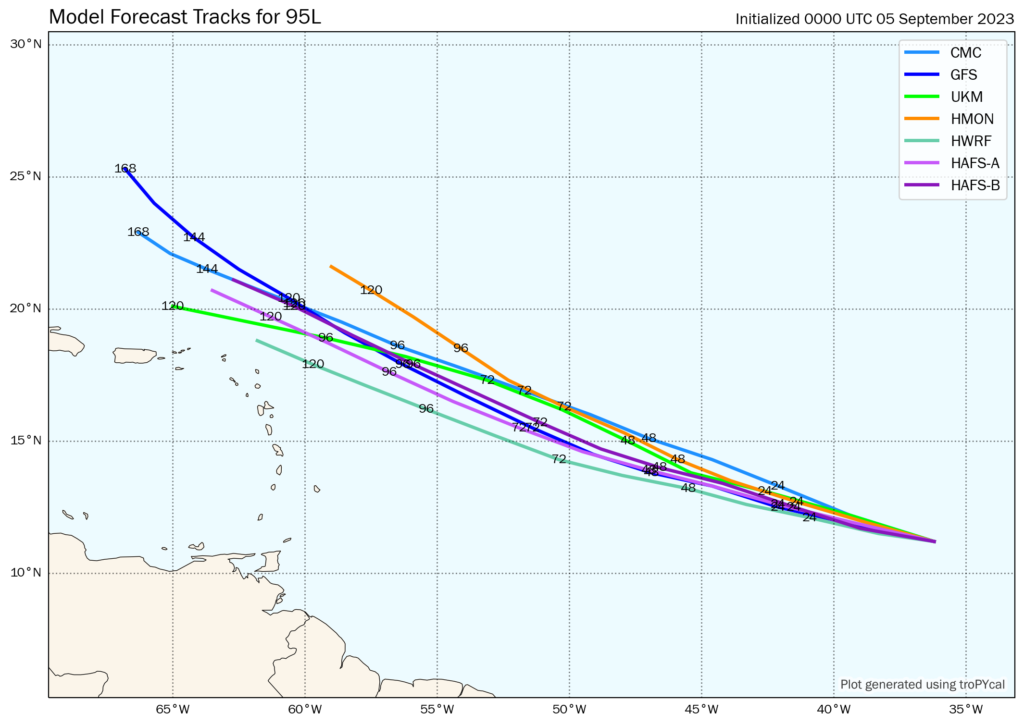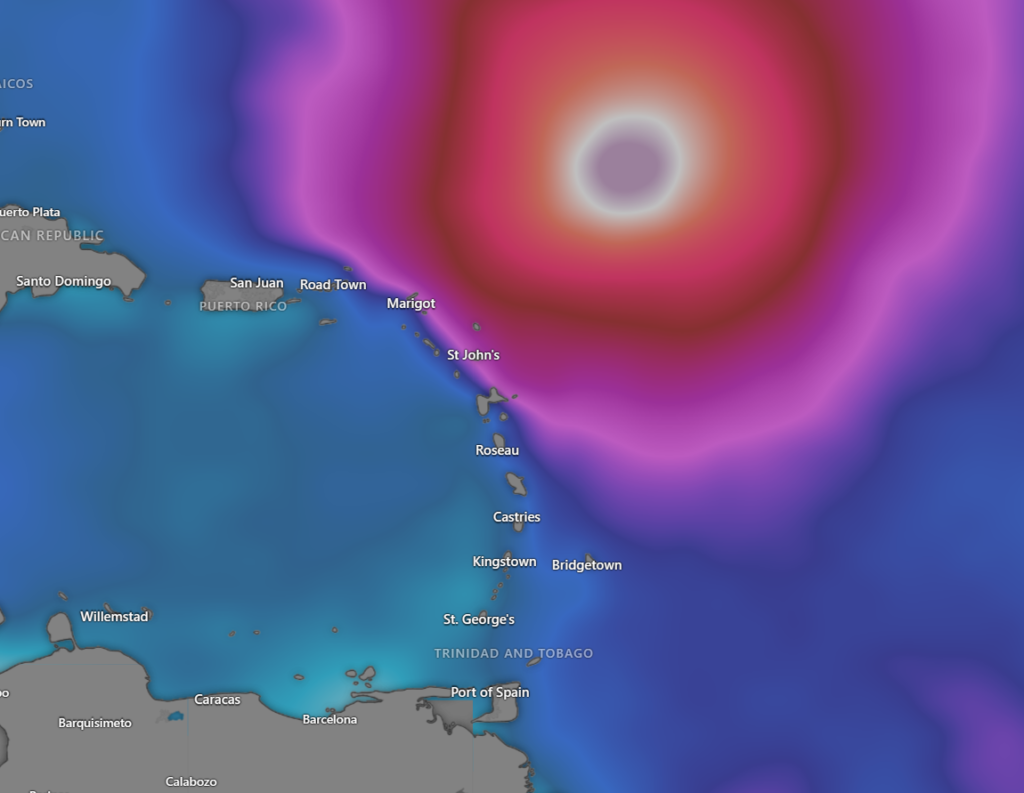A well-defined tropical wave – Tropical Wave 42 – has been designated as Invest 95L and has a high chance of tropical cyclone formation over the next 48 hours and seven days, respectively. Forecast models show significant development of this system over the next several days but keep the potentially powerful tropical cyclone north of the Lesser Antilles, based on model runs on Tuesday morning.
Based on the projected path, this system is forecast to spare the Lesser Antilles from significant winds and rains but will bring weakened winds, increased temperatures, and potentially hazardous seas to the region.
What you need to know
— What has happened: A robust tropical wave, designated as Invest 95L, is being monitored for tropical cyclone formation in the central tropical Atlantic, well east of Trinidad and Tobago.
— Where is it forecast to move: Forecast models have consistently shown Invest 95L, and the eventual tropical cyclone remaining north of the Lesser Antilles based on model runs over the last few days.
— The Intensity & Impacts: Forecast models indicate this disturbance has the potential to become a powerful hurricane, remaining north of the Lesser Antilles. While feeder band activity can’t be ruled out at this time for the Leewards, for the remainder of the Lesser Antilles, mostly hot and sunny conditions are expected. Isolated daytime showers and thunderstorms, favoring the western halves of the islands, are possible from Friday, with agitated seas likely, particularly for the northern half of the island chain.
— Latest from officials: Across the island chain, there are no alerts, watches or warnings. However, several meteorological offices, like Antigua and Barbuda and Barbados, have issued statements on the system.
The latest

At 2:00 AM Tuesday, September 5th, 2023, the approximate center of Invest 95L’s broad low-pressure area was located along 37.5°W, placing it approximately 2,600 kilometers east-northeast of Trinidad and Tobago.
According to the National Hurricane Center’s 2:00 AM Tropical Weather Outlook, “Showers and thunderstorms associated with an area of low pressure located over the central tropical Atlantic about 900 miles west-southwest of the Cabo Verde Islands have become a little better organized over the past several hours. Environmental conditions are conducive for further development, and a tropical depression or tropical storm is expected to form over the next day or so while the low moves toward the west-northwest at 15 to 20 MPH (26-32 KM/H) across the central tropical Atlantic. Additional strengthening, possibly to a hurricane, is likely later this week while the system moves over western portions of the tropical Atlantic, near or to the northeast of the northern Leeward Islands.”
This area of disturbed weather is producing widespread cloudiness with scattered showers and thunderstorms. It is located in a pocket of favorable upper-level divergence, low-level convergence, and a narrow area of light to moderate wind shear. Sea surface temperatures are between 29°C and 30°C with anomalously high atmospheric moisture.

What is an Invest?
In Meteorology, an INVEST (short for an investigative area, also called an area of interest) is a designated area of disturbed weather monitored for potential tropical cyclone formation.
In the Atlantic Basin, these INVESTs are designated by the United States National Hurricane Center, numbered from 90 to 99, followed by the suffix L. These suffixes change for each basin, with “E” and “C” in the Eastern and Central Pacific basins (respectively), or “W” in the Western Pacific basin. Numbers are rotated within the season and are re-used as necessary (the subsequent INVEST after 99 would be numbered 90).
According to the National Hurricane Center, by designating a tropical weather system as an INVEST, the collection of specialized data sets and computer model guidance on the area of interest can begin. This collection and processing of data are shown on several government and academic websites for analysis.
The designation of a system as an INVEST does not necessarily correspond to any particular likelihood of the development of the system into a tropical cyclone.
Where is it going?

Forecast models show Invest 95L being steered west-northwest over the next several days by a subtropical ridge anchored in the North Atlantic Ocean, taking the system generally north of the Leeward Islands.
Over the last 12 or so hours, Invest 95L has maintained a generally west to west-northwestward path, but once this system consolidates, as with most tropical cyclones east of the Lesser Antilles, it begins to move west-northwest as it strengthens.
As it stands on Tuesday morning, Invest 95L and the eventual tropical cyclone from this disturbance is no threat to Trinidad and Tobago. While forecast models keep this low-pressure system north of the Leewards, interest there should pay close attention to forecasts over the next five days as it nears the area.
How strong could it get?

Based on the current forecast tracks, models move Invest 95L through an extremely favorable environment. With an upper-level high above the eventual tropical cyclone, with subtropical jet streams allowing for the storm to be ventilated (outflow leading to favorable upper-level conditions, light to moderate vertical wind shear, high sea-surface temperatures, and a relatively moist environment, leading forecast models and their ensembles show Invest 95L becoming a hurricane in 48 hours and a potential major hurricane in 72 hours.
According to the National Hurricane Center’s 2022 verification report, the consensus models IVCN and HCCA were the best aids overall, while the HWFL was the best individual model. For Invest 95L, these models have continuously shown a strengthening tropical cyclone into a major hurricane by Friday night into Saturday.
What does this mean for the Lesser Antilles?
Given the potential for a higher-end hurricane in the vicinity of the Leewards, interests in the Northern Lesser Antilles should pay close attention to official forecasts in the coming days as this eventual system is forecast to track in that vicinity by Friday night through the weekend. In addition, the close proximity to the eventual system may result in feeder band activity moving across the northernmost Leewards.
For the remainder of the Lesser Antilles, the main hazards from Friday into the weekend will be localized, heat-driven, heavy showers/thunderstorms along western and northern areas of islands, and potentially hazardous seas, particularly for the northern half of the island chain. For the southern half of the region, including T&T, stronger southeasterly winds are likely on Saturday, which may make it to the surface.
Wind

Based on the latest guidance, tropical-storm-force wind gusts and sustained winds (above 34 knots, 39 MPH, 63 KM/H) are forecast to remain north of the northernmost Leewards, but islands north of Guadeloupe and east of Puerto Rico are forecast to experience wind gusts in heavy showers/thunderstorms up to 35 MPH or 56 KM/H. However, this is dependent on how close the core of the eventual system moves to the Leewards. It should be noted that with systems that have not yet formed, there is a larger-than-usual uncertainty in both the track and intensity forecast.
For the central Lesser Antilles, a low-level to surface trough extending southwestward from the eventual low-pressure system will create slack to near-calm winds, leading to hot daytime temperatures and isolated late-morning through afternoon showers/thunderstorms along western and hilly areas.
For the southern Lesser Antilles, including T&T, the pressure gradient between the low-pressure system north of the Lesser Antilles and a high-pressure system over northern South America will lead to strong low-level southeasterly winds across the area from Saturday (the peak) through Monday, which can make it to the surface in showers or thunderstorms. Wind gusts exceeding 45 KM/H are likely during this period.
Rainfall

The highest rainfall accumulations are forecast to occur across the northernmost Leewards, with rainfall totals through Monday, September 11th, 2023, ranging between 25 and 50 millimeters (1-2 inches) with isolated totals up to 75 millimeters (3 inches) based on the current forecast track.
For the central Lesser Antilles, rainfall totals are forecast to be less than 25 millimeters (1 inch).
For Trinidad and Tobago, rainfall totals during this period are also forecast to be less than 25 millimeters (1 inch), with isolated totals up to 50 millimeters (2 inches).
Seas and Storm Surge

Forecast models are showing waves in open waters are forecast to exceed 3.0 meters (9 feet) and up to 4.0 meters (12 feet) near east and north-facing coastlines from Guadeloupe to Anguilla. From Dominica to Barbados, inclusive of St. Vincent and the Grenadines, open water waves can reach as high as 2.5 meters (8 feet). For T&T, seas are forecast to remain moderate, with open waters waves occasionally up to 2.0 meters this weekend into early next week.
Again, this is based on current track and intensity guidance, which can change in the coming days.
For Trinidad and Tobago
Latest Forecast
Active ITCZ Forecast To Affect T&T
Trinidad and Tobago is NOT under any tropical storm or hurricane threat, watch, or warning at this time.
Pay close attention to official forecasts in the coming hours and days from your respective authorities. For Trinidad and Tobago, official forecasts and early warnings come from the Trinidad and Tobago Meteorological Service.










